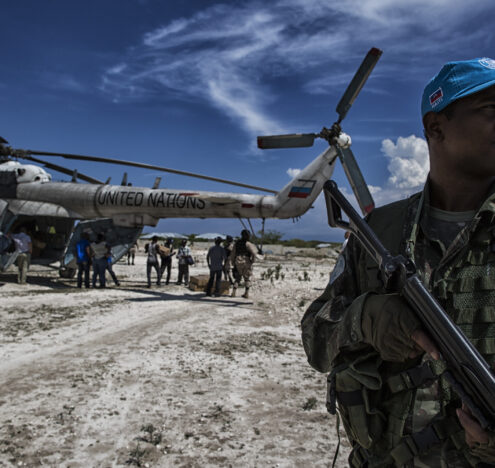Content Warning: This article contains a discussion of rape and sexual assault.
In her groundbreaking 1987 text, ‘Bananas, Beaches, and Bases,’ Cynthia Enloe asks a question about the realm of international relations: “Where are the women?”
Her question stems from the ways traditional approaches to security matters have underestimated or ignored the role played by gender in international relations. However, international relations, as a field of study and as an action, is not gender-neutral. When scholars and practitioners ignore this, gender-based hierarchies become obscured and marginalize women’s unique security concerns around the globe. To prevent this, there are at least two main ways that feminist-informed scholars should analyze how and where women should be included in the historical, present, and future discussions of international relations.
First, we must follow women to places that are usually dismissed by conventional foreign affairs experts as merely ‘private’ matters, or even ‘domestic’, “local,’ and therefore ‘trivial.’ As life is political, kitchens, theaters, closets and even secretaries’ desks can be arenas for international politics. Enloe reminds readers that it is disproportionately women who work as secretaries in foreign affairs ministries, yet “political commentators treat them as if they were no more interesting than the standard-issue furniture.” However, women serving in these roles have had frontstage perspectives of international events as significant as the controversial Iran-Contra Affair and the secret Israel-Palestine peace negotiations in Oslo in the 1990s. Enloe continues by saying:
“Who pays attention to women as clerical workers when, allegedly, it is elite men (and a handful of elite women) who determine the fates of nations? Feminist researchers do…Feminist-informed investigators pay attention to low-status secretarial women because they have learned that taking seriously the observations of women in these scarcely noticed jobs could pull back the curtain on the political workings in lofty state affairs. Devoting attention to women…exposes the far-reaching political consequences of feminized loyalty, feminized secrecy, feminized record-keeping, feminized routine, masculinized status, and masculinized control.”
While physical war is waged mostly by men, it is women who are integral to maintaining nationalist ideals, rhetoric, and on-the-ground practices that come before or after war and in times of increased security and offensive operations. They are the recorders of history in real-time. They offer insight into the rooms “where it happens” and have higher access to politics happening in homes and societies because they proliferate every aspect of them. Their bodies are often also manipulated as a source of justification for violent conflict, symbols of nationalism like Rosie the Riveter, and are even key to colonization efforts, think anything from missionaries using white women as the ideal form of femininity to Carmen Miranda.
As life is political, kitchens, theaters, closets and even secretaries’ desks can be arenas for international politics.
A second place women’s voices and issues should be included in discussions surrounding international relations is that the continuum of violence inherently harms women in peace and war times.
The theory of a continuum of violence refers to the prevalence of sexual and gender violence in the phases of conflict, specifically looking at the linearity of their existence pre-war, during war, and post-war. Historically, the idea of a continuum of violence against women has been dismissed or underreported due to scholars paying little attention to the ways violence against women connects these phases. With this theory, scholars can connect violence that persists throughout pre-conflict, conflict, peacemaking, and reconstruction periods.
This argument for the continuum of violence is perhaps best made in Cynthia Cockburn, who states, “These gender relations [violence during the different phases] are like a linking thread, a kind of fuse, along which violence runs.” And, each of the phases has different ways that violence is represented. For Cockburn, the three phenomena that enable the continuum of violence are economic distress, militarization, and divisive shifts in ideology.
Before wars begin, violence already exists through depressed wages and high unemployment rates that destabilize relations in the family; through marital rape and domestic abuse, through systematic inequalities that do not allow women to gain independence, and through the militarization of society that is reliant on the compliance and engagement of women. Part of the argument for the existence of the continuum of more targeted and specific violence against women during war is that it builds off of an existing structure. By viewing violence against women in a continuum, scholars are also connecting how hegemonic masculinity punishes and controls anything deemed non-masculine for the sake of upholding set power dynamics in their societies, in their battalions, and their prison systems.
During war is when the continuum is most tangible. It is here when mass rape, military sexual slavery, forced prostitution, and forced pregnancies all occur. It is also here that women are forced to offer sex for survival or exchange for food, shelter, or “protection”. But, there is no dignity when a woman is forced to choose rape as a means of survival. While wartime rape is neither universal nor inevitable, it is one of the most salient subjections of humiliation and conquering in war. Catharine A. MacKinnon writes this because “rape is human code for domination” and its impact is that the victim’s identification with their community can be destroyed. MacKinnon explains further, “[As] sex is relational, sexual atrocities destroy relationships. Perhaps in part because it is seen and felt to destroy one’s humanity and relational place in community indelibly and irreparably.” To destroy a community, you start with the women. And this is how violence against women in wartime is justified and maintained. It is also how violence against women continues post-war. Rape creates community vulnerability which restarts the continuum.
Some may point to the fact that wartime rape is often not an intentional strategy of war; that it is more frequently tolerated than ordered. Yet, still, it falls on the continuum because the lack of punishment or correction by commanding officers to their troops for rape proves that it is viewed as an acceptable action; that women “inherently” play this role during war, and that it is just “men being men”. These assumptions lead to violent ends. There are others who still argue that because perpetrators are not exclusively male, nor are victims exclusively female, the continuum of violence cannot be applied universally. And while it is true that female perpetrators of rape exist, as do male victims, the purpose behind these acts is either in pursuit of social cohesion with a highly masculine group or to create power dominance and to emasculate their enemies, their inferiors. And the need to “emasculate” in itself implies that “femininity” is the “other” and weak, therefore rendering the practice of violence.
The costs of war rely on women’s bodies, and the continuum of violence against women shows this. Women are the bearers of life, the glue in social cohesion, and the necessary method for militarization to occur. In war, they are the easiest targets and the most straightforward and cruel catalysts to expose group vulnerability for generations after the war. They bear the brunt of violence at all stages of the conflict, not during just wartime. Policy and research should acknowledge this.
My organization, Women for Weapons Trade Transparency (W2T2) aims to do just this. In a world (and professional field) where women are left out of not only policymaking but also the research of the impacts of war, W2T2 centers them. No discussion of security issues, arms trade dealings, and modern warfare can occur without the expertise and lived experiences of women.
So where are the women? They are preserving domestic and public spaces, they are living the impacts of policy and organizing for their communities, and they are leading the fight to be included in the international security sphere.
Olivia Owens is a Member of Women for Weapons Trade Transparency. She is a senior at Indiana University double majoring in Sociotechnical Conflict and Central Eurasian Studies. Women for Weapons Trade Transparency envisions a world in which the manufacture, sale, and use of arms and weapons of war has drastically decreased, where inter and intrastate conflicts are mitigated peacefully, and where every human being is safe, secure, and free from oppression.





















